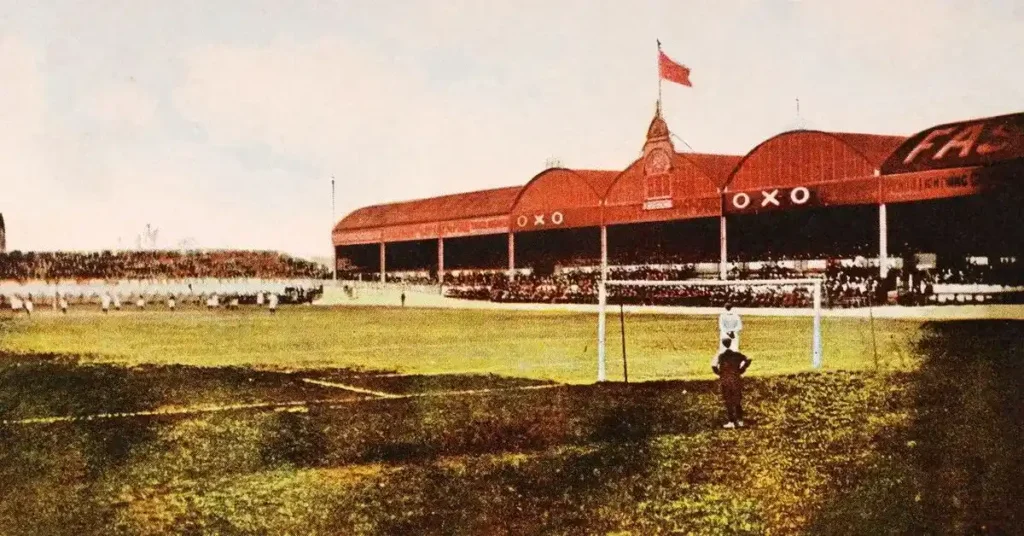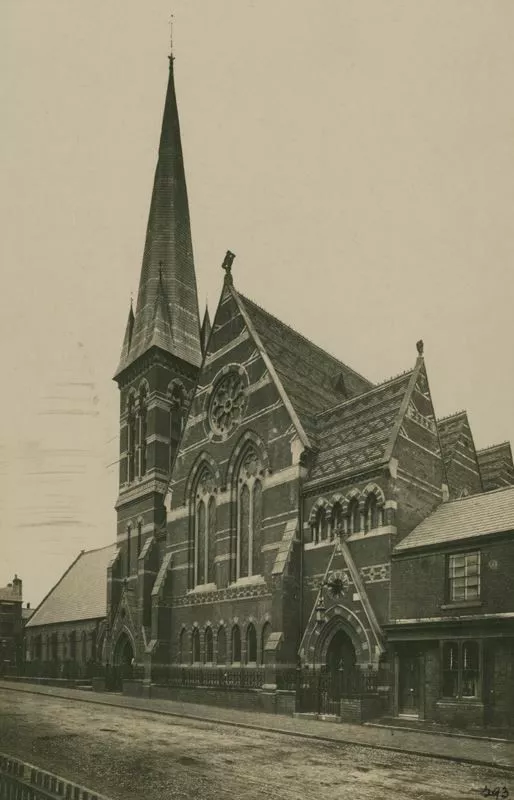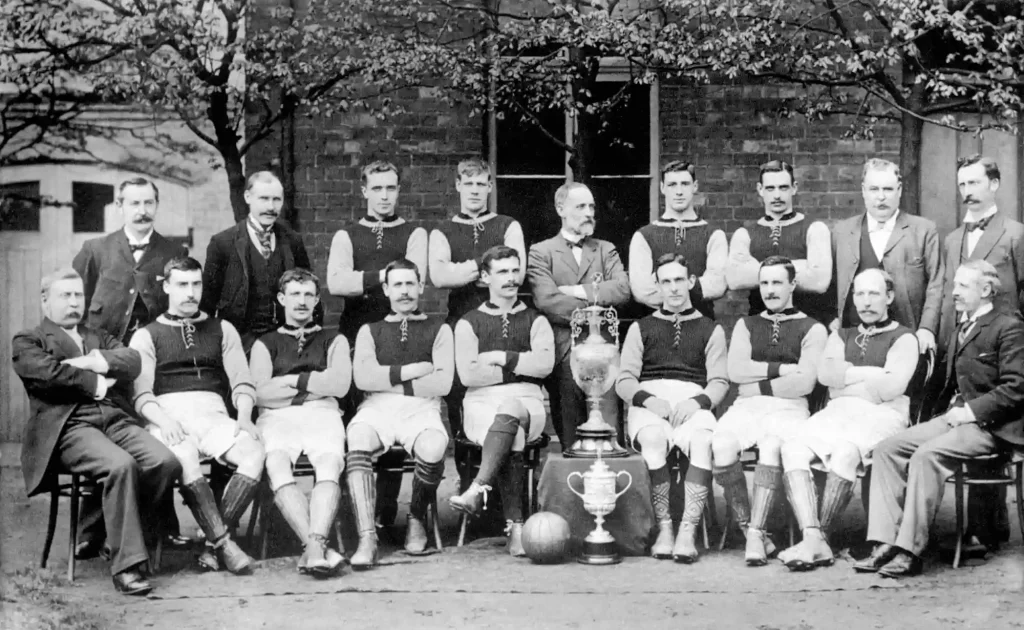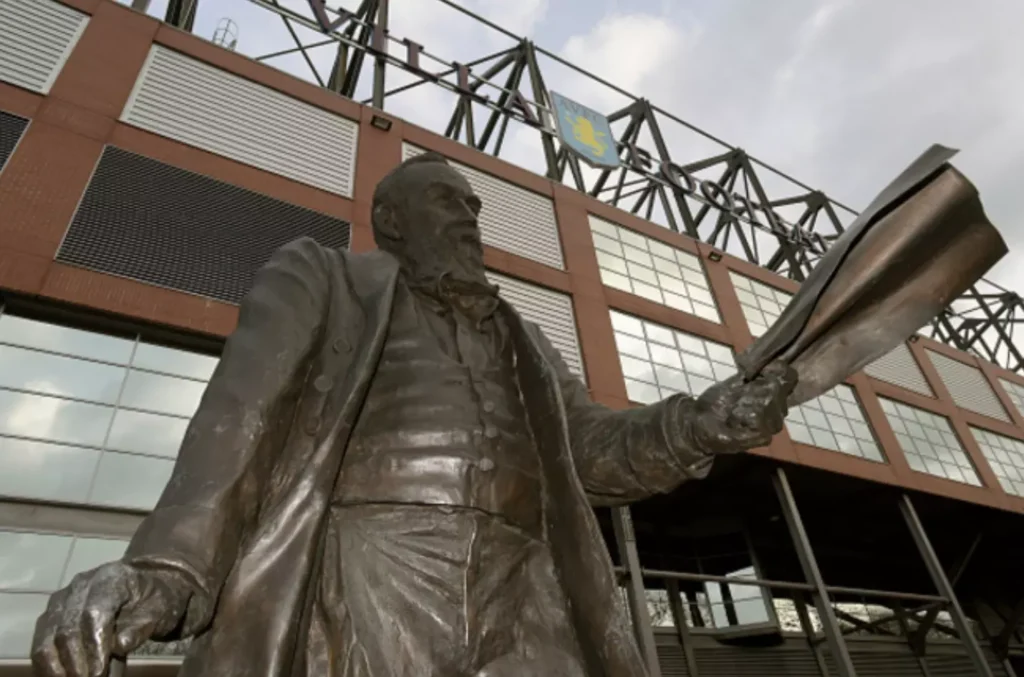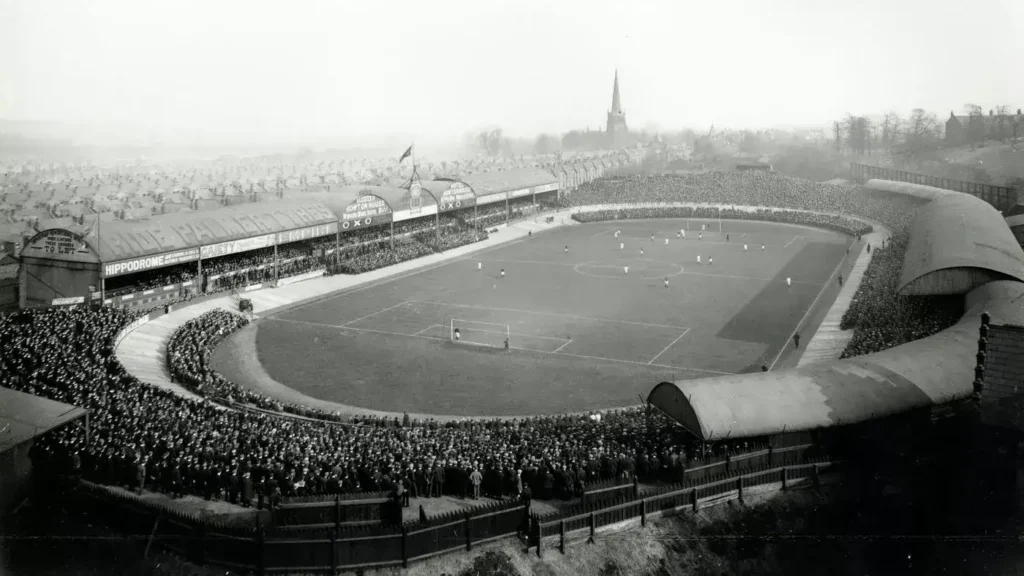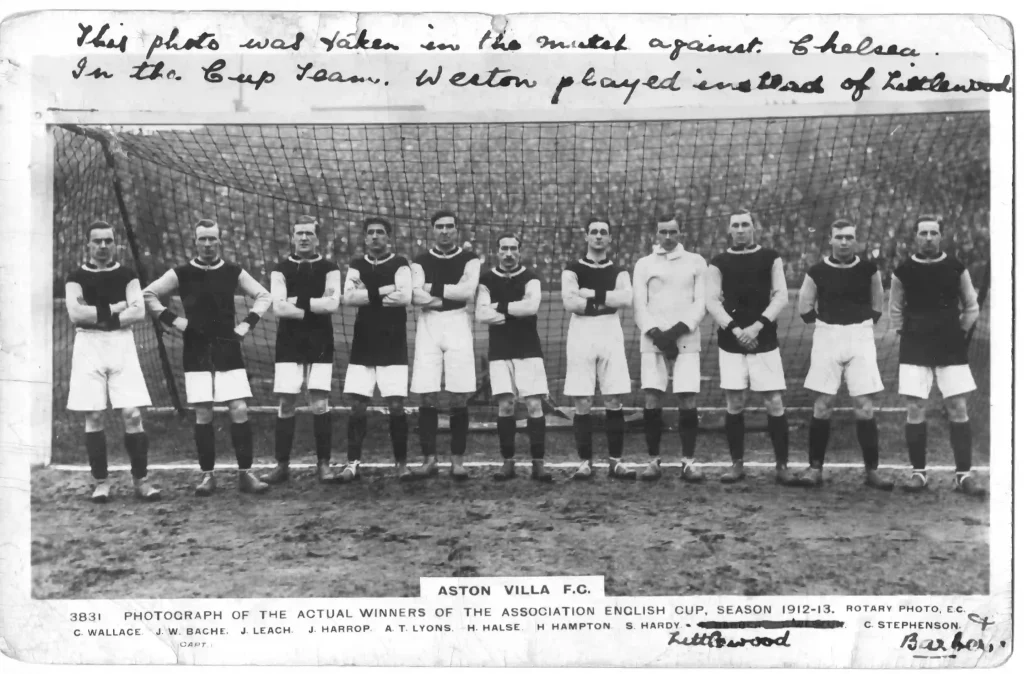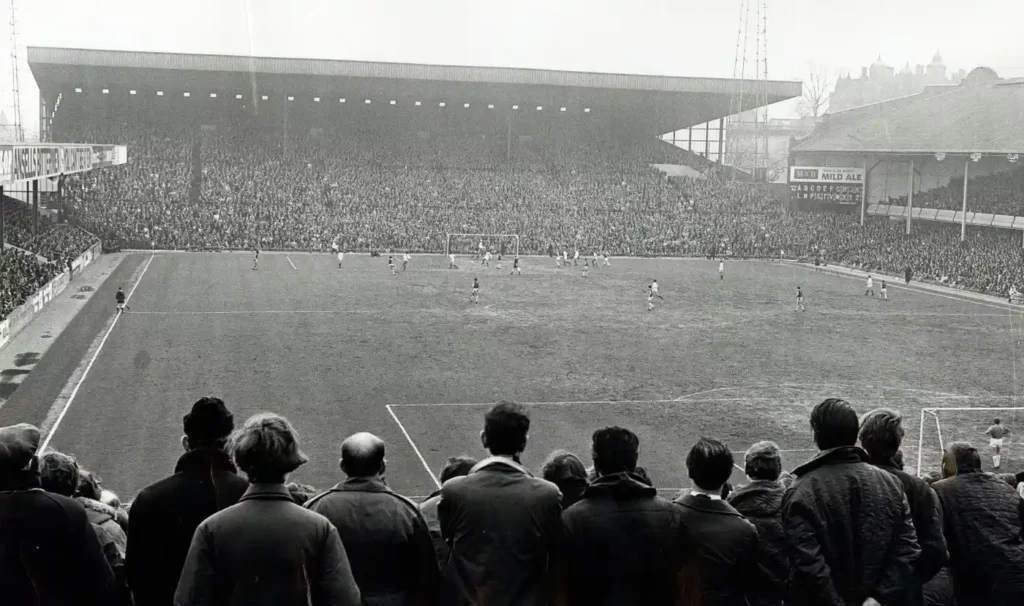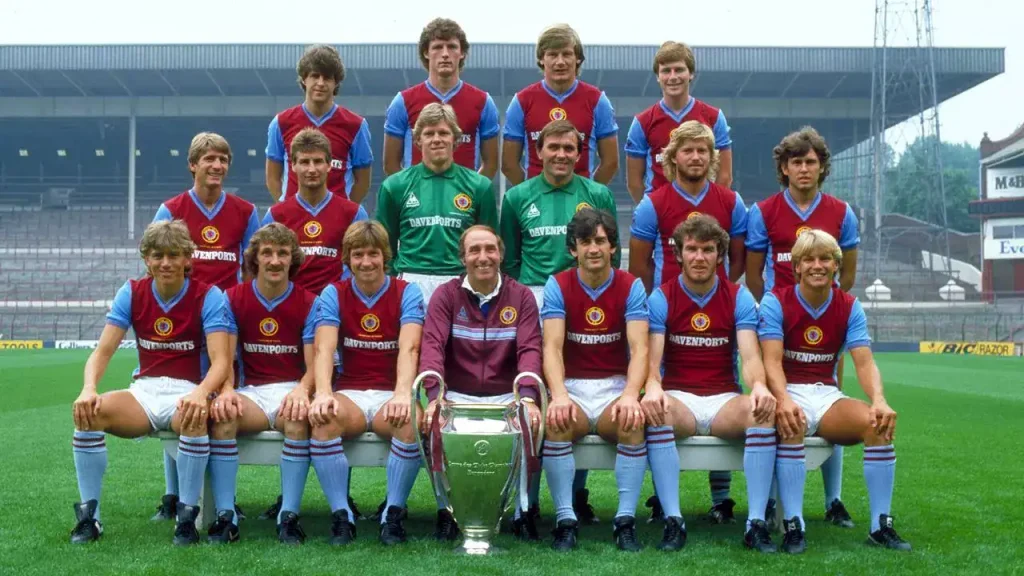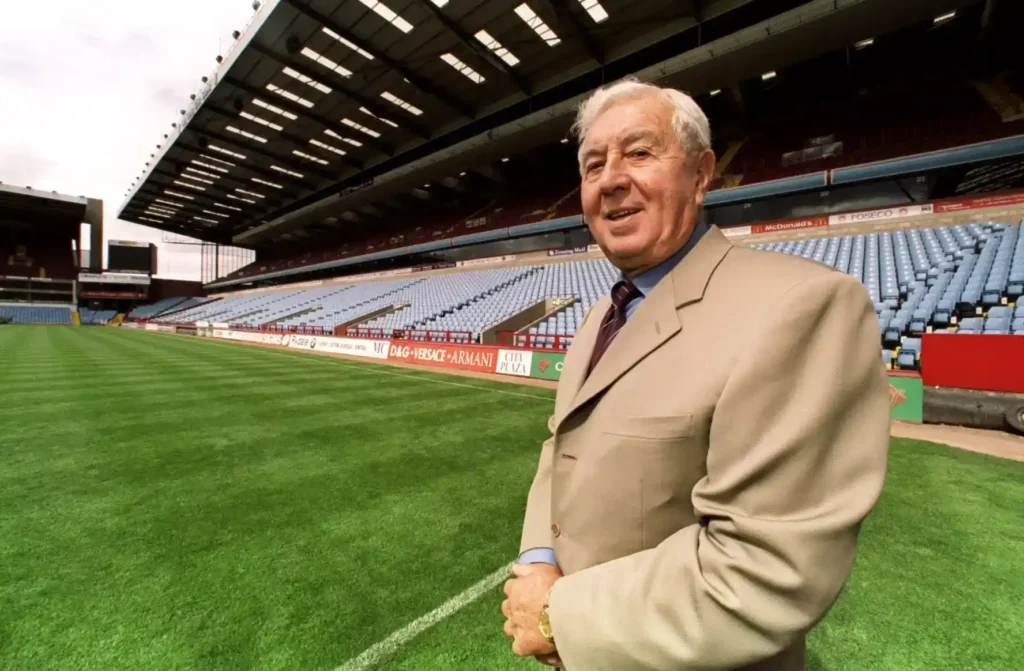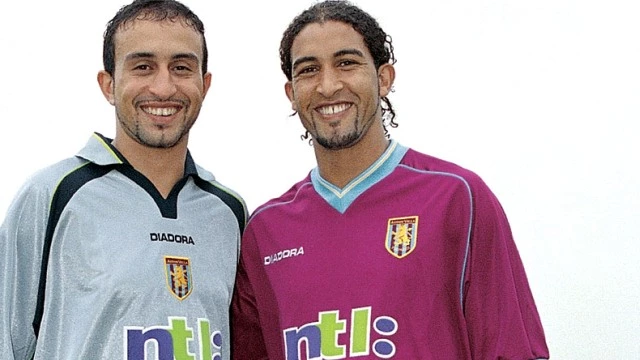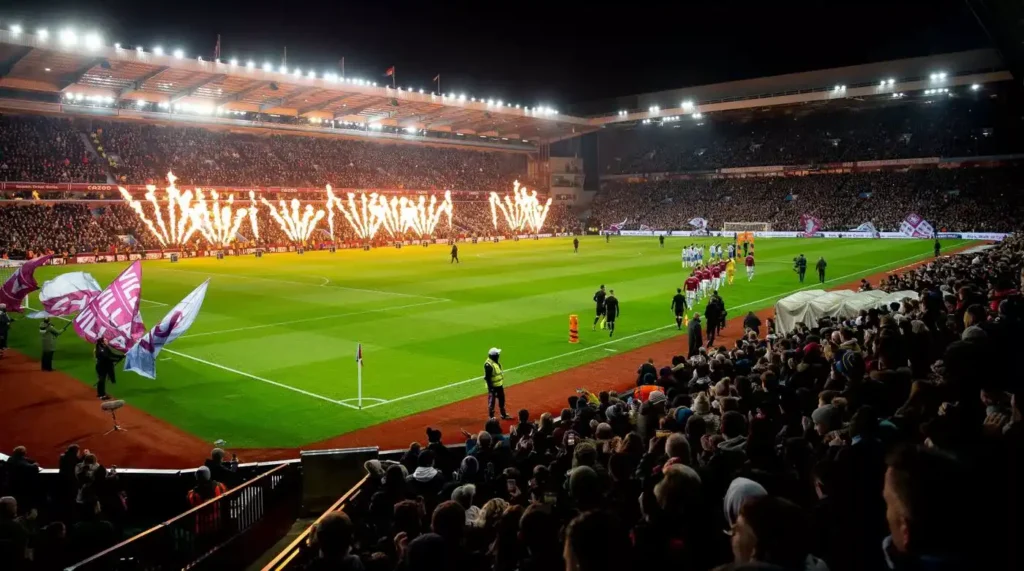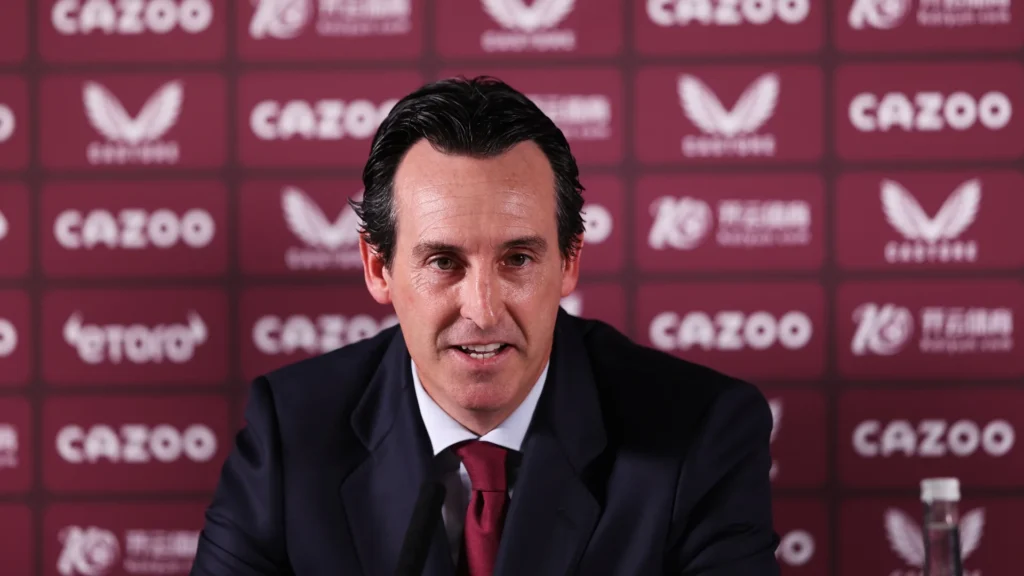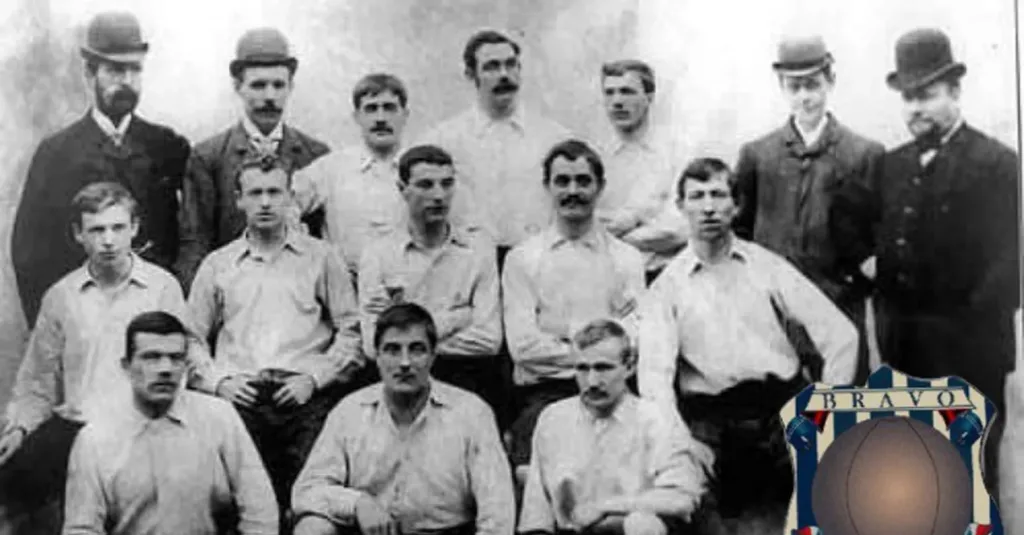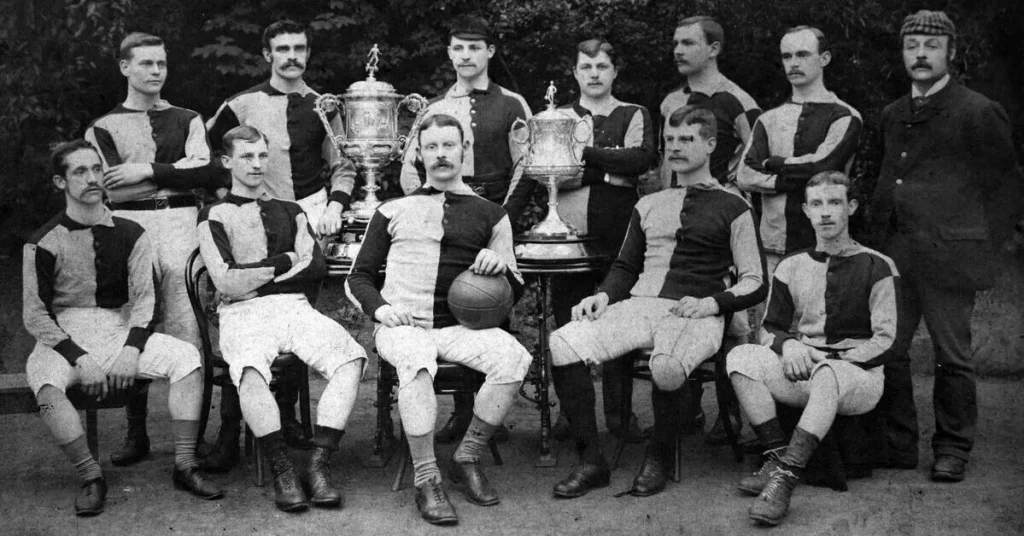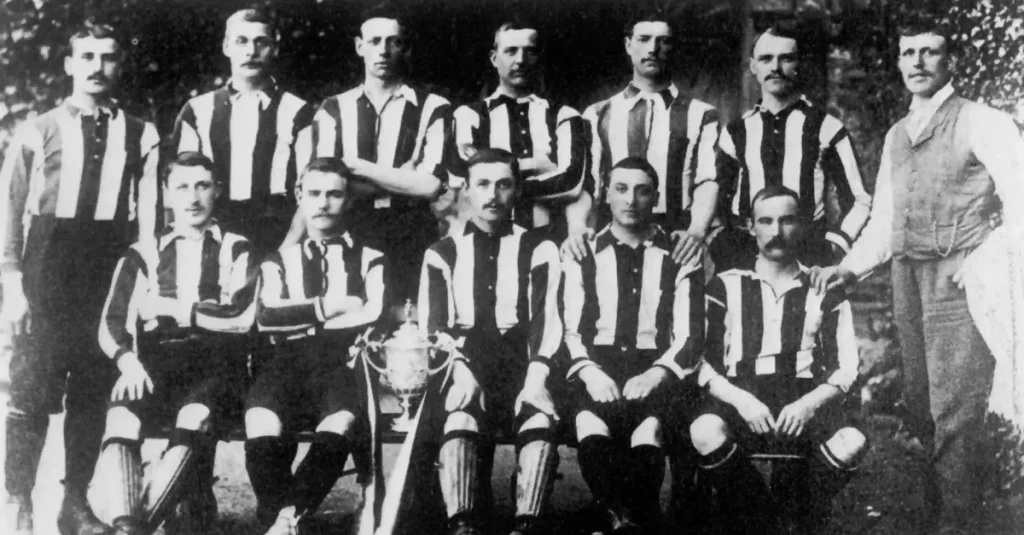English professional football club Aston Villa is based in Aston, Birmingham. Aston Villa history started back in 1874.
In 1888, Aston Villa joined the Football League. In 1992, it joined the Premier League. The club has a rich history, having won the European Cup (now known as the Champions League) in 1982 and the First Division (now known as the Premier League) on seven occasions.
Seven FA Cups and five League Cups have also been won by Aston Villa. Despite their success, the club has struggled and has been relegated from the top division on three occasions. Despite this, Aston Villa remains one of the most successful and well-supported clubs in English football.
Aston Villa History Between 1874 – 1887
The Football League was founded in 1888 by Villa, but its story begins with four men: Jack Hughes, Frederick Matthews, Walter Price, and William Scattergood. According to legend, the quartet from the Villa Cross Wesleyan Chapel cricket team met under a gas-light in Heathfield Road in 1874 to form a new club.
In search of an activity to occupy themselves during the long winter months, they turned their attention to the beautiful game after witnessing an impromptu match on Heathfield Road meadow.
In 1874, Aston Villa made their debut against Aston Brook St Mary’s in an unusual match played under rugby rules in the first half and association rules in the second half. Jack Hughes scored the goal in the 1-0 victory for Villa.
A three-year lease was negotiated on the Perry Barr HQ for £7 10s in the first year, rising to £15 in the second and £20 in the third. Villa moved to their first proper home in 1876.
During the late 1870s, Villa became dominant in the region, hammering neighbors Small Heath 22-0 in one memorable match.
During the 1880/81 season, Villa won 21 of 25 matches and the Staffordshire Cup. A quarter-final appearance in the 1883 and 1884 FA Cups illustrated the fledgling club’s progress.
With a 2-0 victory over West Brom at The Oval in April 1887, Villa won the prestigious competition. In just 13 years, Aston Villa had become one of the best teams in the country.
Aston Villa History Between 1888 – 1899
Villa led the Football League’s formation as director William McGregor called the country’s leading clubs to a meeting on 2 March, 1988. At a subsequent meeting, the 12 founding members of the new competition were selected, and Villa was one of them.
Tom Green scored Villa’s first League goal in a 1-1 draw with Wolverhampton Wanderers on 8 September, 1888. In their inaugural season, Aston Villa finished runner-up to Preston. During the 1893/94 season, Villa won the League Championship with 20 goals from John Devey.
In 30 League games, Perry Barr Pets (Aston Villa’s original nickname) scored 84 goals to win the title. A year later, Devey helped Villa win a second FA Cup, this time over West Bromwich Albion. A 1-0 victory over The Throstles avenged the 3-0 loss a few years before.
A year later, Villa won the League and Cup double for the second time in three years. After finishing 11 points ahead of Sheffield United, Villa beat Everton 3-2 in the FA Cup Final at Crystal Palace.
Fifteen thousand fans attended Blackburn’s first home game at Aston Lower Grounds after the double season ended with a move to the new stadium. A dramatic League season two years later saw Aston Villa win the Championship trophy again after beating Liverpool 5-0 on the final day.
Aston Villa History Between 1900 – 1939
The gap between Aston Villa and its rivals was closing as the 20th Century began. However, Villa remained one of the most influential forces in football despite becoming more competitive. A significant amount of rebuilding was needed by the team.
It was a false dawn for the Claret and Blue boys in 1900-01 as they finished fourth from bottom in the league table. A poor start to 1902-03 was followed by 12 wins in 15 games to finish agonizingly close to champions Sheffield Wednesday.
With the FA Cup captured in 1904-05, the club enjoyed more success. A record-breaking crowd of 101,117 watched the 1905 final at Crystal Palace, which captured the imagination of London’s football fans.
Harry Hampton was the star in the 2-0 win over Newcastle United. A fourth-place finish in the league wasn’t bad, either. While planning to buy Villa Park outright, the club’s directors welcomed a welcome injection of cash from the successful season.
The purchase wouldn’t be completed until 1911 after Fred Rinder and his colleagues negotiated it. Although Villa finished distant runners-up to Manchester United three years after their FA Cup triumph in 1905, it was in 1909-10 that they truly threatened to reclaim their position at the top of English football.
During that season, Villa defeated Blackburn Rovers (4-3) and destroyed Manchester United (7-1).
By mid-April, Aston Villa had just one win away from an unassailable lead, despite never winning the championship for a decade. With a 3-2 win over Notts County, Villa took their record sixth title.
During the summer of 1910, the champions were confident about defending their title. Between mid-October and mid-December, Villa won nine consecutive matches, compensating for an indifferent start to the campaign.
On the season’s final weekend, Villa played Liverpool at Anfield, while Manchester United played third-placed Sunderland at home. Sunderland lost 5-1 to the Red Devils, while Villa lost 3-1 to the Reds.
The agonizing conclusion to the 1910-11 season left Villa Park with an inevitable hangover. The following season, they finished sixth, eight points behind Blackburn Rovers.
A 1-0 victory over Sunderland at Crystal Palace in 1913 gave Villa their fifth FA Cup victory. As soon as World War One broke out, any hopes of a new golden age were dashed.
After the first World War, Villa won the 1919-20 FA Cup with a 1-0 victory over Huddersfield Town at Stamford Bridge.
Golden Jubilee Season
At Wembley Stadium for the first time in 1923-24, Aston Villa reached the FA Cup final during its Golden Jubilee season. The hope of a seventh victory in the competition ended with a 2-0 loss to Newcastle United.
The directors attempted to avert the slide by making bold transfers following league finishes of sixth and tenth, respectively. During the 1927 season, the team recruited goal-scoring winger Jimmy Gibson and dead ball specialist Eric Houghton.
There was, however, still more to come. An incredible deal was struck with Tranmere Rovers for Tom ‘Pongo’ Waring the following year for £4,700. As Villa finished runners-up to Arsenal in the 1930-31 season, Waring scored 49 league goals. From the wing, Houghton scored 30 goals.
At the end of the 1935-36 season, Villa was relegated to the Second Division after a sharp decline. The Second Division title was won in 1938 by Jimmy Hogan’s side at the second attempt. Then came the Second World War.
Aston Villa History Between 1946-67
World War Two had cost league football seven seasons and many successful careers by the time it resumed in August 1946. A 50,000-strong crowd packed into Villa Park for some proper league football after spending so long watching the football equivalent B-movies.
Villa’s only goal of the opening match was scored by Wilf Mannion against Middlesbrough. They lost to Everton two days later.
For £9,500, manager Alex Massie signed 23-year-old Wales international Trevor Ford from Swansea. As a result, Ford scored 60 goals in his four seasons, and the Claret and Blue boys finished eighth that season.
Johnny Dixon, a young winger who became a fan favorite, was another forward making his mark for Villa in the 1940s. In 1948, Massie’s young team finished sixth, but the following season started disastrously for the history of Aston Villa. They lost six of them in the first eight games, and relegation looked likely.
The directors brought Con Martin (Leeds United) and Ivor Powell (QPR) to get out of trouble. It worked this time. However, Villa remained bottom of the table after another run of six losses in eight games.
Massie switched to a more direct style of play to make better use of Trevor Ford’s predatory instincts. As a result, they secured mid-table safety with only one loss in their remaining 17 fixtures.
After a poor start to the 1950-51 season, Massie left Villa Park. The successor was another Scot, George Martin, from Newcastle United. A relegation battle ended in relief rather than elation for him in his first season.
A talented player from his old club – Tommy Thompson – has been added to his squad. During his time with the Claret and Blues, he scored 67 league goals in 149 matches.
Danny Blanchflower, an expensive signing from Barnsley, was the most influential signing. It was an Irish theme in 1951-52, with Walsh at the front, Blanchflower in the middle, and Con Martin at the back. Despite its seeming absurdity today, the Villa manager switched his center-half to goalkeeper.
In the end, Villa finished sixth in a respectable sixth place after eight games, their most successful start in 19 years. It could be attributed to the maturity of the midfield, with Blanchflower, Moss, and Dorsett complementing each other.
In 1952-53, the club finished in the middle of the table. Next season, Martin left, and Eric Houghton returned as manager from Notts County. 19-year-old Peter McParland was promoted to the first team and endeared himself to the fans.
The gaffer continued to blood youngsters like Ken Roberts, Joe Tyrrell, and Derek Pace after he made an immediate impact. Despite finishing 13th, the Aston Villa young team did well under Houghton to achieve respectable results in the top flight.
Blanchflower, the midfield general who asked for a transfer, finally left Tottenham Hotspur for £30,000. Thomson followed him, for £25,000, to Preston.
Aston Villa were doing well under Houghton’s management, especially in the 1957 FA Cup. A replay enabled them to defeat West Bromwich Albion in the semi-final, and they faced Manchester United, the Busby Babes, in a record-equaling ninth FA Cup final.
It was 0-0 at halftime, but McParland scored after 66 minutes, heading in Dixon’s cross. Six minutes later, McParland scored a second to become a hero.
FA Cup Victory
The FA Cup victory of 1957 didn’t mark the beginning of a new era for the club. A seven-point margin separated Villa from relegation at the end of the 1957-58 season.
The following term, mediocrity, gave way to crisis. Houghton paid the inevitable price for being relegated from Division One. His resignation was invited by the board.
He declined and was fired. As ironic as it may seem, he was negotiating with Hearts on the night of his dismissal for winger Dave Mackay for a fee of £15,000. At season’s end, Villa would be relegated, while Mackay would win a double with Tottenham Hotspurs two seasons later.
As a result of Houghton’s departure, Sheffield United manager Joe Mercer was appointed to replace him. The relegation season’s only highlight was reaching the FA Cup semi-finals, losing out to Nottingham Forest 1-0.
In the end, a goal by Ronnie Allen against the Villans in the 88th minute sent West Bromwich Albion down, with the team battling hard to avoid relegation.
Villa won Division Two by a comfortable margin ahead of Cardiff, so there were no long-term concerns. After beating Leeds, Chelsea, Port Vale, and Preston in the FA Cup, Villa lost to Wolves in the semi-final at the Hawthorns.
The upward trend continued in Division One, with Mercer guiding the team to ninth place while Spurs defeated them in the FA Cup final. Among Villa’s greatest achievements this season was reaching the League Cup final after eliminating seven teams, including Preston and Burnley, along the way.
Villa had to play the final early the following season due to their pre-confirmed tour of Russia. By then, they had lost Hitchens to Inter Milan.
Derek Dougan replaced him in July 1961, signing for £15,000 from Blackburn Rovers. As a result, he couldn’t compete in the final against Rotherham United, which was played over two legs. At Millmoor, Ralph Brown led the line as a 17-year-old. A poor performance by Villa led to a 2-0 defeat, which prompted Mercer to reward his team with a £90 bonus.
As a result, Alan O’Neill, Harry Burrows, and McParland all scored to seal the cup for the defending champions. A young team under Mercer seemed to have a bright future. However, after finishing seventh in 1962, Villa entered a downturn, finishing fifteenth, followed by the Claret and Blue boys in fourth place.
In July 1964, Mercer resigned due to illness. However, it is likely that the hurt he felt from being made the scapegoat for the club’s problems played a part in his decision.
Following a terrible start to the season, Dick Taylor took over, and Tony Hateley banged in goals to keep Villa in Division One in 1964-65. Next season, Villa finished 16th before a 4-2 loss to Everton on the final day condemned them to Division Two.
Aston Villa History Between 1967 – 1986
In contrast to previous lower league adventures, this time, Aston Villa were relegated again before they began their long road to the top division. Still, it was for a slightly extended period of time.
In 1967-68, Tommy Cummings was appointed manager, and he walked into Villa Park expecting to return the club to Division One.
Nevertheless, as November approached, Villa was in the bottom four, and Cummings had to rethink his strategy. Brian Godfrey, Brian Greenhalgh, and Dick Edwards were among the new players he signed immediately.
In November, Villa again struggled, and the board parted ways with Cummings, though only a month later, they were on their way out after a series of hostile protests from all sides, including Birmingham’s Lord Mayor.
Doug Ellis, a local travel agent, was appointed to lead a new board of directors, and his first task was to bring Villa back from financial ruin. In 1968, Villa Park needed urgent repairs, attendance was falling rapidly, and Villa Park was in debt of £200,000.
In his half of a season as manager, new manager Tommy Docherty inspired the team just enough to keep them above water. Docherty was more important, however, for he caught the public’s imagination and crowds returned. The attendance at their last home game of the season against the Blues more than doubled after Docherty joined the club.
In 1969-70, however, the club slipped into Division Three because he couldn’t build on this success. By mid-January, Vic Crowe had replaced him, but there was no immediate revival.
It was a short-lived disappointment for Villa as they were crowned champions in the 1971-72 season. Lochhead and Graydon got the goals, but a 32-conceded defensive record sealed the title.
In 1972-73, they came close to promotion but finished third, with only the top two going up at the time. Having failed to deliver top-quality football under Crowe, Ron Saunders was called upon.
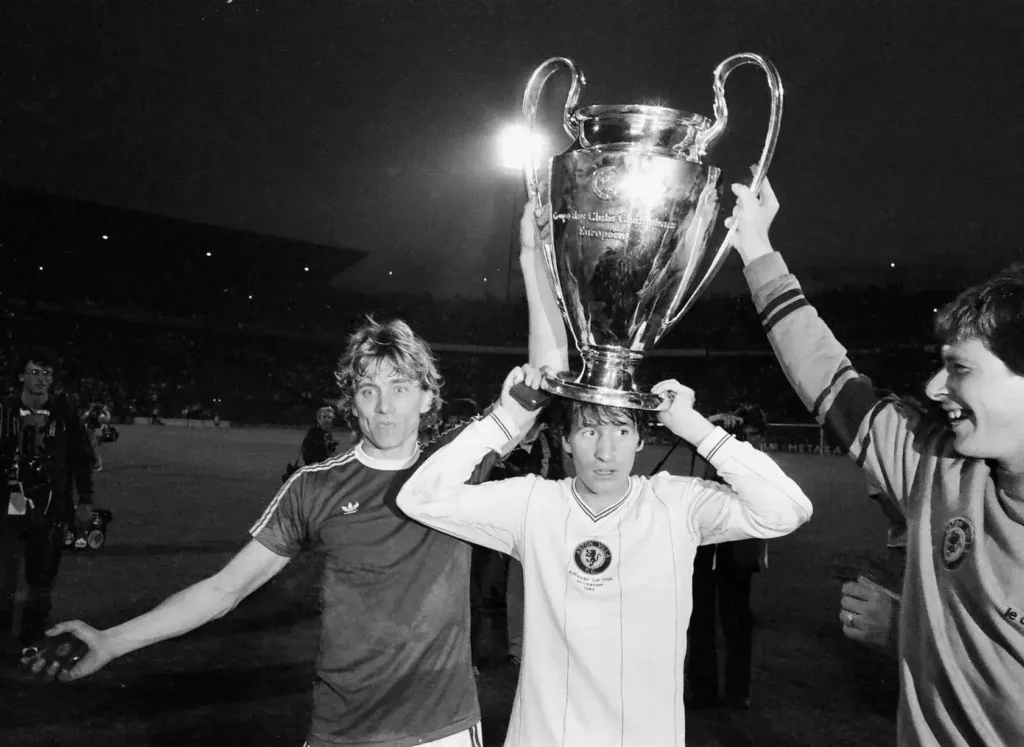
In 1975-76, Villa returned to the First Division and won the League Cup, qualifying them for Europe for the first time. Antwerp defeated them 5-1 in their first appearance in the competition.
Despite finishing fourth in the league, they reached the quarter-finals of the FA Cup and won the League Cup again in a 3-2 victory over Everton.
Villa reached the quarter-finals of the UEFA Cup in 1977-78, where they lost to Barcelona 4-3 on aggregate. After that, Saunders decided they needed to rebuild domestically.
In defense, Allan Evans, Ken McNaught, and Kenny Swain took on the responsibility. Des Bremner joined Mortimer, Cowans, and Tony Morley in midfield, while Gary Shaw and Tony Morley led the attack. In the summer of 1980, Peter Withe was signed from Newcastle to complete the rebuilding.
English Champions
Villa’s 12-match unbeaten run in the autumn of 1980-81 propelled them to the top of the table. As a result, Villa’s first Division One championship in 71 years came about when Championship rivals Ipswich also lost at Middlesbrough on the last day of the season.
As Villa’s European Cup exploits dominated 1982, the Claret and Blue boys slipped to mid-table in their defense of the title. Despite progressing past Valur and Dynamo Berlin in the early rounds, all was not well at the club, and in February, Saunders resigned.
The club was guided to safety within three months by Tony Barton, whose soft-spoken manner made him a favorite with the fans. A thrilling final against Bayern Munich featured a goal from Peter Withe. It was a string of brilliant saves by rookie keeper Nigel Spink, who came on for Jimmy Rimmer after only 10 minutes to deny the Germans.
Despite winning the European Super Cup and finishing sixth in the league in 1983, Villa’s fortunes plummeted in the mid-1980s.
Six years after his replacement by Sir William Dugdale, Doug Ellis returned as chairman of Villa Park in December 1982 and revealed within a year that the club had debts approaching £2 million.
In the summer of 1984, Ellis replaced Tony Barton with Graham Turner. While he maintained Villa’s top-10 league position in his first season, he struggled to deal with the size of the club and was sacked in 1986.
Aston Villa History Between 1986 – 2004
Billy McNeill replaced Turner, but the club was still relegated, some eight points away from the safety zone.
In Division Two for the first time in 12 years, Villa started the 1987-88 term with another new manager, Graham Taylor, who had achieved much acclaim from his day at Watford.
He immediately changed the playing staff, bringing in Kevin Gage, Steve Sims, and Alan McInally and selling Gary Williams, Paul Elliott, and Tony Dorigo. The team struggled in the opening weeks, taking only one win from their first six matches, but their promotion bid gathered steam after an away win against West Bromwich Albion in early September.
In the end, it was close, with Bradford and Middlesbrough losing their final game of the season and the claret and blue troops holding out for a point at Swindon to go up in the runners-up spot.
After a season of consolidation, Villa started the 1989-90 term with more changes from Taylor. First, he strengthened with two center-backs, Kent Nielson and Paul McGrath. With that pair, allied with the class of Gordon Cowans, Tony Daley, and David Platt, the team mounted a strong challenge for honors.
They chased Liverpool in the league to finish as runners-up and reached the quarter-finals of the FA Cup.
David Platt marked his marvelous season by establishing himself in the England side during the 1990 World Cup. He was soon joined by Graham Taylor, who was appointed national side manager soon after the tournament ended.
So for the 1990-91 term, Aston Villa was again looking for a new manager. Doug Ellis made a bold move by appointing Czech national team manager Jozef Venglos. Unfortunately, the decision didn’t bear fruit and the following season saw another gaffer installed, with Venglos replaced by the flamboyant Ron Atkinson.
Big Ron marched into Villa Park, intent on leading the club to glory. In a flurry of transfer activity, which saw ten players leave and eleven arrive within his first year, he soon laid the foundations for some long-awaited success.
The New English Premiership Era
In his first season, Villa climbed to seventh in the table and reached the quarter-finals of the FA Cup. In his second, they were neck and neck with Manchester United in the league before they eventually settled for second place.
More significantly, at this time, he bought together the unique partnership of Dean Saunders and Dalian Atkinson. It helped Villa to the League Cup in 1993-94, with the team running out 3-0 winners over favorites Manchester United.
Atkinson delivered the silverware the club so desperately craved. Still, the league form was different from what Doug Ellis wanted, and he soon lost his patience and sacked the flamboyant ex-West Brom and Manchester United gaffer.
The chairman moved quickly to replace Atkinson with Brian Little, the brilliant forward who had delighted fans in the 1970s. Alan Wright and Gary Charles joined for a combined fee of £1.8m, with lifelong Villa fan Ian Taylor transferred from Sheffield Wednesday to beef up the midfield.
They managed to survive the drop that season, with Crystal Palace dropping through the trap door on the final day. In came more signings, including Gareth Southgate, Ugo Ehiogu, Mark Draper, and, of course, Savo Milosevic. However, the opening day victory over Manchester United 3-1 was not a false dawn for the club as they climbed to fourth in the table.
But more importantly, an away goals victory over Arsenal had granted Little’s troops a place in the League Cup final, and they would use this match against Leeds United to produce one of their finest performances at Wembley.
A crowd of 77,065 were present, and Milosevic scored one of the best goals in a significant final midway through the first half. Taylor scored the second after some neat build-up play with Wright, and it was Savo created the third, totally deceiving the defense as he passed to Dwight Yorke to complete the job.
If that had been the pinnacle of Savo’s career, the all-time low was just a season away. Having seen their team capitulate to Blackburn Rovers, losing 5-0 at Ewood Park, the supporters let rip, and Milosevic took the brunt. He had suffered a poor game, but nothing could excuse his reaction of spitting in the direction of the fans.
He was placed on the transfer list the following week, and he would leave at the end of the season after the departure of Little.
Speculation as to who would take charge began immediately, but Ellis wasted no time in announcing the appointment of John Gregory. The former Wycombe boss quickly dipped into the transfer market, bringing in Paul Merson, Dion Dublin, Steve Watson, Colin Calderwood, Mark Delaney, and Steve Stone.
This offset the loss of Dwight Yorke to Manchester United for a club record £12.6m.
After completing his first season in charge, John Gregory was confident his team could press for honors in 1999-2000. He again tied up deals, with George Boateng and David James winging their way in. Vying for a place in Europe, they managed sixth place in the Premiership, but the players’ form in the knock-out competitions excited the Aston Villa fans.
A tremendous run in the Worthington Cup saw them reach the semi-finals, but they were to have another stab at glory in a more prestigious competition. Benito Carbone had been bought in to replace the injured Dion Dublin, who had broken his neck just before Christmas.
And the Italian scored a superb hat-trick to see the club past Leeds United in the fifth round. Further victories over Everton and Bolton helped the club reach the showpiece event at Wembley. Unfortunately, it was a day to forget as the team went down 1-0 to Chelsea, with Roberto Di Matteo netting the decisive goal.
More comings and goings were on the cards as Steve Watson, Mark Draper, Alan Thompson, and Stan Collymore jumped ship, with David Ginola, Alpay Ozalan, and Luc Nilis all hopping on board the good ship Villa. Nilis’ stint finished before it started, the Belgian suffering a horrific career-ending injury in a clash with Richard Wright.
Gregory must have thought things couldn’t get worse, but they did, with Ugo Ehiogu making his way out of the club to Middlebrough for £8m.
Although Juan Pablo Angel, Moustapha Hadji, Olof Mellberg, and Peter Schmeichel made their way to Villa, captain Gareth Southgate followed Ehiogu out of the club to Middlesbrough for £6.5m.
Results fluctuated in 2001, and the club finished the season in eighth place. Then, Gregory stunned everyone in January 2002 when he resigned from his position as club manager to take up the same position at Division One-bound Derby County. Naturally and understandably, his decision dominated the back pages of the national papers.
Two weeks later, Ellis reappointed the man he never wanted to lose in the first place, and Graham Taylor became boss. The ex-England manager had rejoined the club as a non-executive director after ‘retiring’ from management following a second spell with Watford.
He had decided that his training pitch days were over until the chairman offered him the one job he could not refuse. His main signing was Peter Crouch from Portsmouth, with Dion Dublin spending the end of the season on loan at Millwall. Villa eventually finished eighth.
The following season did not go according to plan, with the team finishing 16th in the Premier League, primarily caused by failure to win enough away games, the only success coming in a 5-2 demolition of Middlesbrough.
The result? The resignation of Taylor soon after the season ended. Former Leeds boss David O’Leary was installed as manager in another chapter of the Claret and Blue story.
O’Leary made a slow start to his first season in charge. He added Thomas Sorensen and Gavin McCann in the summer, but Villa struggled by the turn of the year.
Nobby Solano was signed from Newcastle during the January transfer window, and his arrival coincided with a dramatic upturn in fortunes. Villa’s form over the second half of the season was second only to champions Arsenal, and O’Leary’s men finished sixth – missing out on Europe by goal difference.
O’Leary’s second season in charge was frustrating as injuries eventually took their toll, and Villa slipped out of the race for Europe to finish tenth in the table.
With the strikers struggling for goals, it was left to midfielders, notably Solano, Hendrie, and Barry, to provide the firepower. One bright spot was undoubtedly the emergence of young midfielder Steven Davis.
Aston Villa History Between 2005 – Present
Aston Villa’s league finishes kept fluctuating in the mid-2000s despite changing managers. Villa’s poor start to the season had them teetering around the relegation zone all season, leading to the sacking of manager David O’Leary in the Summer of 2006 to be replaced by Martin O’Neill.
The club finished 16th in the league despite spending over £13 million on transfers, signing Kevin Phillips, Milan Baroš, and Wilfred Bouma, among others.
Long-serving chairman and majority shareholder Doug Ellis also departed, selling his 38% stake in the club to Randy Lerner, also the owner of the NFL team Cleveland Browns.
During the 2006-2007 season, Martin O’Neill’s first in charge, Villa started the season strongly and was the last team to get beaten, losing 3-1 to Liverpool. In the meantime, they had taken points off Arsenal and Chelsea during the 9-game unbeaten run.
Villa’s Olof Mellberg scored the first competitive goal at the new Emirates Stadium, with January arrivals like Ashley Young, John Carew, and Shaun Maloney influential in the squad.
However, a mid-season wobble saw them lose 11 on the trot before eventually recovering only to lose 3 in the final 15 games. Villa finished 11th with 50 points, ending the season on a 9-game unbeaten run. The team also got to the FA Cup third and fourth rounds in the League Cup.
The 2007–08 season was Villa’s 20th consecutive season in England’s top flight and the 16th since the Premier League launched. Martin O’Neill’s team impressed in the league, finishing 6th to qualify for the UEFA Intertoto Cup. their cup form wasn’t as good, exiting domestic cups in the third round.
Villa went on to win the Intertoto Cup, beating Danish side Odense BK in a 2-leg final to qualify for their first European football in seven years. They also beat Ajax 2-1 at Villa Park in the 2008–09 season to reach the UEFA Cup group stages.
In 2008-2009, Villa signed Curtis Davies, Steve Sidwell, Brad Friedel, and Nick Shorey, among others. The team started strongly, sitting third on 51 points after 25 games, 2 points above Chelsea and eight above Arsenal.
However, Villa’s rotten run of 8 winless games ended top 4 hopes, finishing 6th to qualify for the Europa League.
A Successful Season
2009-2010 was a successful season for Villa. Despite Europa League elimination at the play-off round, Martin O’Neill’s men enjoyed lengthy runs in the domestic cups, reaching the FA Cup semi-finals.
Villa also finished runners-up in the League Cup to go with another 6th-place league finish for the 3rd year in a row. The club lost long-time midfield Gareth Barry, who joined Manchester City in June 2009 after playing for Villa since 1997.
The club reached its first final of the Randy Lerner era in 2010, losing the League Cup final 2–1 to Manchester United at the New Wembley.
Five days before the 2010–11 season, Martin O’Neill immediately resigned. Kevin MacDonald, the reserve team coach, took caretaker charge of the first games of the season before Gérard Houllier was hired on 8 September 2010 to replace him.
However, Houllier suffered a recurrence of a heart problem and left his post on 1 June 2011, with former Birmingham manager Alex McLeish joining to replace him. McLeish also left at the end of the following season with the club narrowly avoiding relegation.
Paul Lambert replaced Alex McLeish as manager during the off-season and took charge of his first game during a 1-0 opening-day loss to Newcastle United. His first win came on 15 September 2012, a 2-0 victory over Swansea City at Villa Park.
Villa’s poor league form continued, losing 8-0 to Chelsea for the club’s heaviest-ever defeat in the English top flight. Consecutive heavy defeats at home, 4-0 to Tottenham and 3-0 to Wigan Athletic, compounded their misery, but the club rallied late to finish 15th. There was also a League Cup run to the Semi-finals but suffered an FA Cup exit in the fourth round.
A bright start to the 2013-2014 season faded midway through, seeing Villa slump down the league to finish 15th. Villa was also eliminated in the third round of both cups.
On 11 February 2015, Villa manager Paul Lambert was sacked and replaced by Tim Sherwood 3 days later. On 19 April, Villa came from behind to beat Liverpool 2-1 at Wembley, reaching their first FA Cup final since 2000.
They lost the final 4-0 to Arsenal. In the league, a topsy-turvy season saw the Villans finish 17th while exiting the League Cup in the second round.
The 2015-2016 season ended Villa’s Premier League stay. Despite having Tim Sherwood, Kevin McDonald (interim), Remi Garde, and Eric Black (temporary) as managers during the season, a goal drought meant the club finished 20th and was relegated to the championship.
Aston Villa remained in the second tier for three seasons, finishing 13th in 2016-2017 and 4th in 2017-2018.
2018-2019 saw Villa change managers mid-season again, with Dean Smith joining the club on 10 October 2018 to replace Steve Bruce. Smith revitalized the team’s attack and made academy graduate Jack Grealish captain on 2 March 2019 to inspire the attack. Chelsea loanee Tammy Abraham’s 25 league goals powered Villa to 5th, qualifying for end-of-season play-offs.
On 22 April 2019, Villa broke a 109-year club record for the longest winning run, beating Milwall 1-0 at Villa Park for a 10th win in 10 games.
The club finished 5th in the Championship regular season and won the play-off final at Wembley to secure promotion to the Premier League. Villa also reached the FA Cup third round but exited the EFL Cup in the second.
Villa finished 11th in the league during the 2020-2021 season and was eliminated from the FA and EFL Cups in the third and fourth rounds, respectively. The club joined the FA cup in the third round, losing their only game to Liverpool 1-4 on 8 January 2021 after fielding Under-18 and Under-20 players due to Covid-19.
Aston Villa’s third consecutive season in the premier league after promotion was a rocky one. Manager Dean Smith was sacked on 7 November 2021 and replaced by former Glasgow Rangers manager Steven Gerrard, who steadied the ship to finish 14th in the league. The club underperformed in the cup, exiting both at the fourth round stage.
